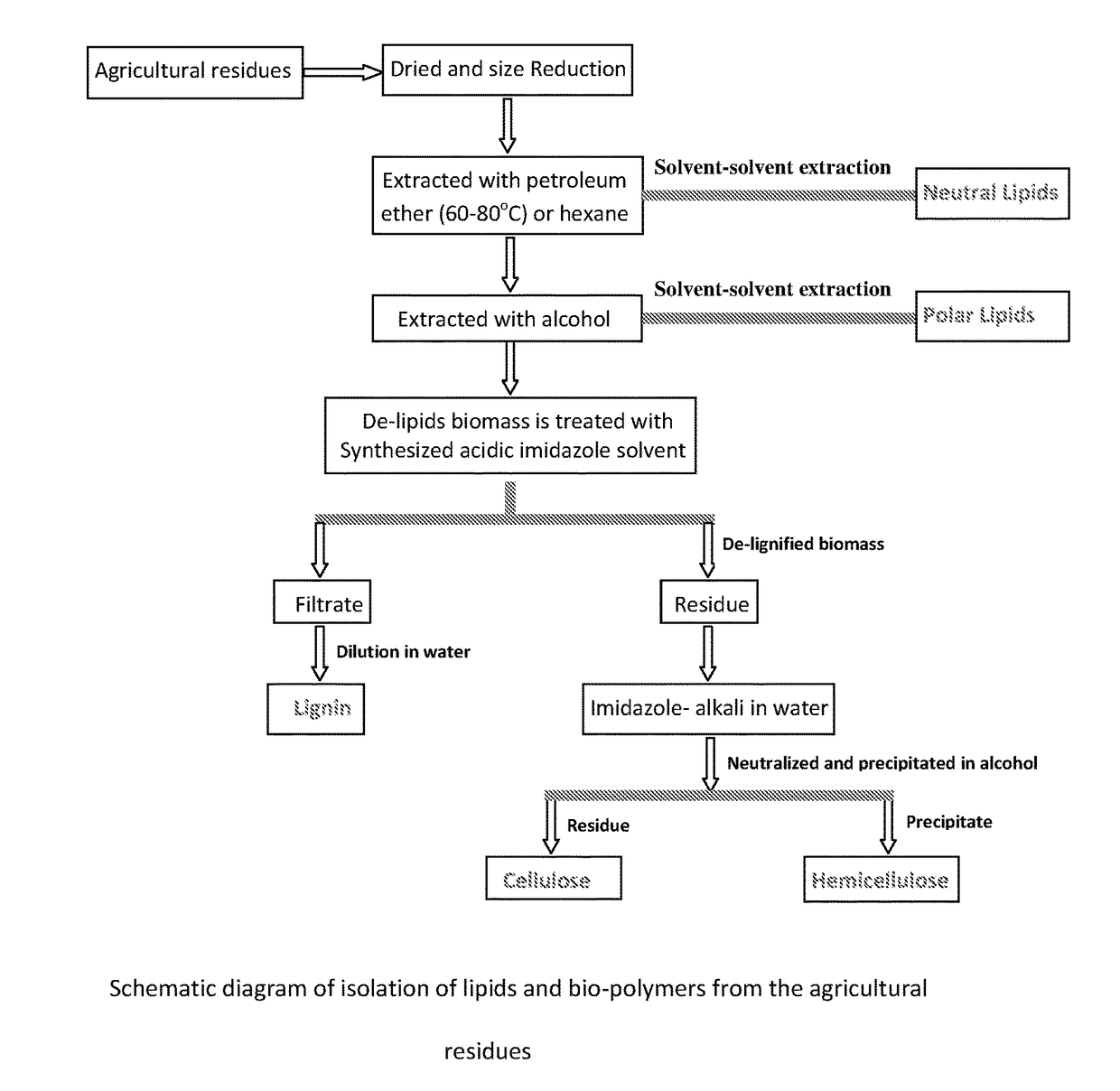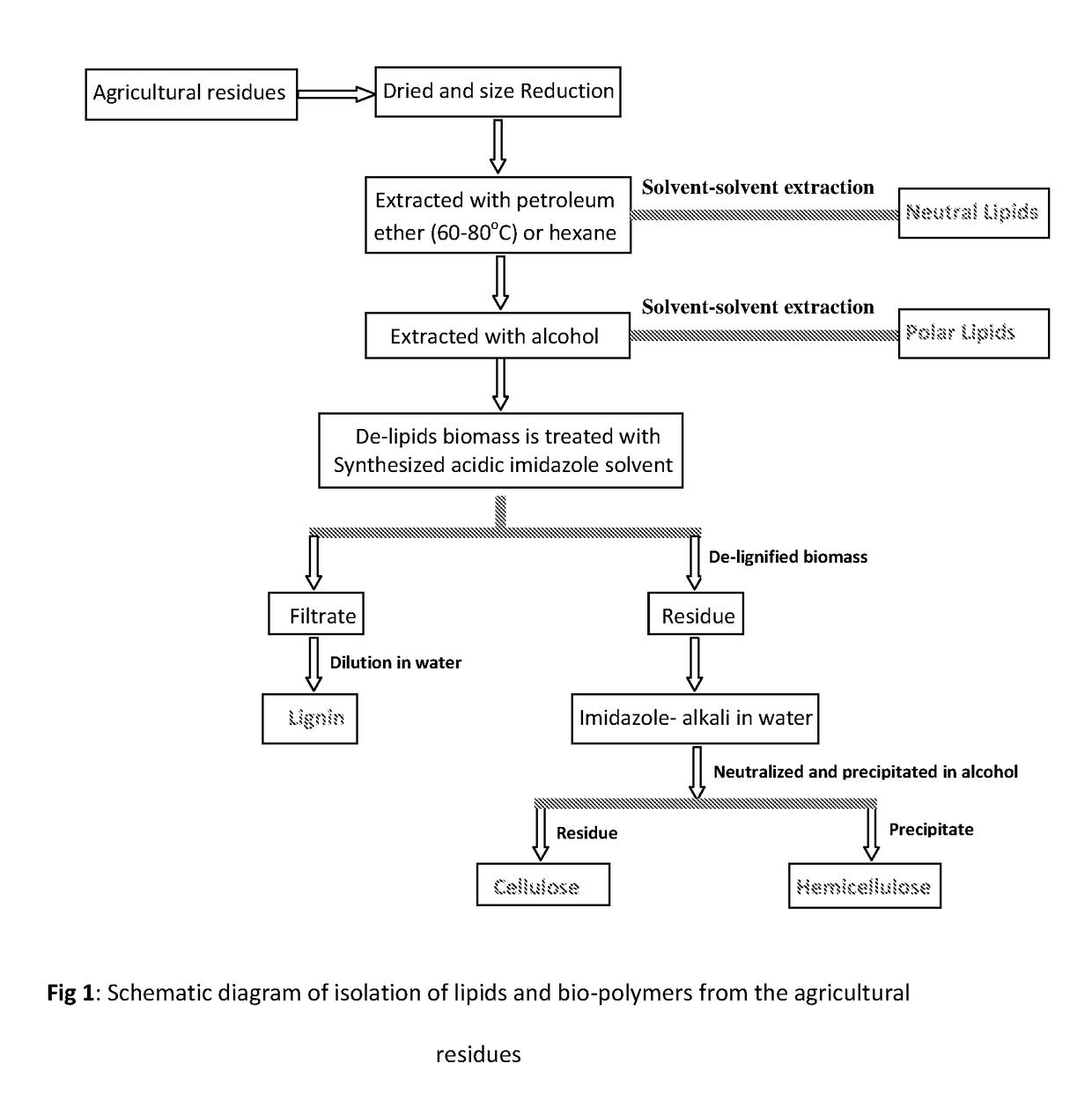An eco-friendly process for the isolation of biopolymers from agricultural residues
a biopolymer and biopolymer technology, applied in the direction of solvent extraction, fatty oil/fat separation, separation process, etc., can solve the problems of environmental impact, degradation and occurrence of undesired side reactions, and the new ionic liquid technology for large-scale application still shows limitations in recoverability and cost, and achieves low cost, low cost, and easy hemicellulose.
- Summary
- Abstract
- Description
- Claims
- Application Information
AI Technical Summary
Benefits of technology
Problems solved by technology
Method used
Image
Examples
example 1
[0066]Air dried and pulverized spent mentha biomass (50 g) was extracted with 220 mL of hexane in a Soxhlet apparatus for 3 h. The solution was concentrated under vacuum and weight of the extract was 1.2 g (2.4%). The extract was charged with chilled methanol to precipitate the waxes. It was filtered and the methanol extract was concentrated. Again portioned the extract with hexane-water and hexane soluble portion was treated with 0.2 g of fuller's earth. Finally, filtered and concentrated the filtrate to obtain the neutral lipids (0.35 g, 0.7%). The raffinate biomass was again extracted with methanol (200 mL) in a Soxhlet apparatus for 3 h. The solution was concentrated under vacuum and weight of the extract was 2 g (4%). It was solubilised with aqueous alcohol and concentrated and then portioned with ethyl acetate. Further, ethyl acetate soluble portion was treated with 0.1 g of fuller's earth, then filtered and concentrated to obtain the polar lipids (0.15 g, 0.3%). After drying,...
example 2
[0067]Air dried and pulverized spent Ocimum biomass (50 g) was extracted with 200 mL of petroleum ether (60-80° C.) in a Soxhlet apparatus for 4 h. The solution was concentrated under vacuum and weight of the extract was 1.3 g (2.6%). The extract was charged with chilled ethanol to precipitate the waxes. Filtered it and concentrated the ethanol extract. Again portioned the extract with hexane-water and hexane soluble portion was treated with 0.2 g of fuller's earth. Then filtered and concentrated to obtain the neutral lipids (0.4 g, 0.8%). The raffinate biomass was again extracted with ethanol (200 mL) for 3 h. The solution was concentrated under vacuum and weight of the extract was 2.2 g (4.4%). It was solubilised with aqueous alcohol, then concentrated the aqueous extract and portioned with chloroform. Further, chloroform soluble portion was treated with 0.1 g of fuller's earth, then filtered and concentrated to obtain the polar lipids (0.13 g, 0.26%). After drying, the weight of ...
example 3
[0068]Air dried and pulverized spent citronella biomass (50 g) was extracted with 250 mL of petroleum ether (60-80° C.) in a reflux stirrer reactor for 4 h. The solution was concentrated under vacuum and weight of the extract was 1.25 g (2.5%). The extract was charged with chilled methanol to precipitate the waxes. Filtered it and concentrated the methanol extract. Again portioned the extract with petroleum ether-water and petroleum ether soluble portion was treated with 0.2 g of fuller's earth. Then filtered and concentrated to obtain the neutral lipids (0.4 g, 0.8%). The raffinate biomass was again extracted with ethanol (220 mL) for 4 h. The solution was concentrated under vacuum and weight of the extract was 2.3 g (4.6%). It was solubilised with aqueous alcohol, then concentrated the aqueous extract and portioned with dichloromethane. Further, dichloromethane soluble portion was treated with 0.1 g of fuller's earth, then filtered and concentrated to obtain the polar lipids (0.17...
PUM
| Property | Measurement | Unit |
|---|---|---|
| Fraction | aaaaa | aaaaa |
| Fraction | aaaaa | aaaaa |
| Time | aaaaa | aaaaa |
Abstract
Description
Claims
Application Information
 Login to View More
Login to View More - R&D
- Intellectual Property
- Life Sciences
- Materials
- Tech Scout
- Unparalleled Data Quality
- Higher Quality Content
- 60% Fewer Hallucinations
Browse by: Latest US Patents, China's latest patents, Technical Efficacy Thesaurus, Application Domain, Technology Topic, Popular Technical Reports.
© 2025 PatSnap. All rights reserved.Legal|Privacy policy|Modern Slavery Act Transparency Statement|Sitemap|About US| Contact US: help@patsnap.com


